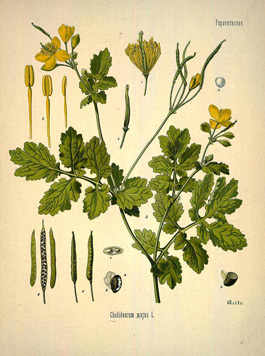Clarifying Celandine
By Audrey Stallsmith

It is called Celandine not because it first springeth at the comming in of Swallowes, or dieth when they go away. . .but because some hold opinion, that with this herb the dams [mother swallows] restore sight to their yong ones when they cannot see.
John Gerard, Gerard’s Herball
Celandine already has begun popping up in my garden before the return of the swallows. In his 1597 Herball, John Gerard describes it as “having leaves not unlike those of Columbine” and juice “of the colour of Saffron.” In a month or so, the plants also will produce yellow blooms “in shape like those of the Wal-floure [wallflower].”
I know that I planted the double-flowered variety myself, but can’t remember whether the single-flowered type was there already or whether I was responsible for it too. I did plant a lot of strange things back in my herbal phase!
Since there are several celandines, I should specify that I am speaking of greater celandine (Chelidonium majus), not the “lesser” variety (Ranunculus ficaria)--which actually is a type of buttercup--or celandine poppy (Stylophorum diphyllum), an American native with larger blooms. Although greater celandine is a biennial, it self-sows heavily enough to make itself perennial.
Its black seeds are cunningly furnished with edible-to-ants “tails” which encourage those insects to distribute the seeds in their quest for supper. Native to Europe, Asia, and northern Africa, the plant has become naturalized here in the U.S. too. Colonists brought it with them because its orange “blood” was supposed to be a surefire cure for warts, corns, and eye problems.
Oddly enough, that explains its name deriving from the Greek khelidon (“swallow”), since that bird purportedly treated eye diseases in its young with celandine. Gerard discounted that idea with the equally unlikely notion that young birds’ sight naturally healed itself, though he did agree that “the juice of the herb is good to sharpen the sight, for it cleanseth and consumeth away slimie things that cleave about the ball of the eye. . .”
I wouldn’t recommend celandine juice as an eyewash for either birds or humans, since it reportedly is extremely acrid and also contains toxic alkaloids. We can only hope that the people who used it to remove warts didn’t lick their fingers! The plant was a popular remedy for liver ailments too.
I can’t say how well it worked for any of those problems, but the fact that the flower stands for “deceptive hopes” may be an indication! In his 1869 Flora Symbolica, John Henry Ingram comments that “It is pretty well-known now-a-days that the only benefit the sight gets from these wild blossoms is in the pleasure derived from gazing upon them.”
Also, the herb actually can cause hepatitis when it is over- consumed. So, to be on the safe side, you probably should just grow this plant, also known as swallow wort, for its charm.
Unfortunately, no one seems to have written an ode for it, as Wordsworth did for the lesser celandine. But I still find that idea of the mother swallow dropping a golden cure into the eyes of her young poetical—even if it isn’t true!
The Chelidonium majus image is from Kohler's Medizinal-Pflanzen, courtesy of plantillustrations.org.








